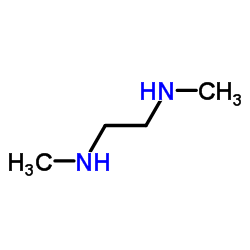N,N'-二甲基乙二胺

N,N'-二甲基乙二胺结构式

|
常用名 | N,N'-二甲基乙二胺 | 英文名 | 1,2-Dimethylethylenediamine |
|---|---|---|---|---|
| CAS号 | 110-70-3 | 分子量 | 88.151 | |
| 密度 | 0.8±0.1 g/cm3 | 沸点 | 120.0±0.0 °C at 760 mmHg | |
| 分子式 | C4H12N2 | 熔点 | N/A | |
| MSDS | 中文版 美版 | 闪点 | -11.4±12.0 °C | |
| 符号 |


GHS02, GHS05 |
信号词 | Danger |
|
Redox effects and cytotoxic profiles of MJ25 and auranofin towards malignant melanoma cells.
Oncotarget 6 , 16488-506, (2015) Malignant melanoma is the most dangerous type of skin cancer. Although recent progress in treatment has been achieved, lack of response, drug resistance and relapse remain major problems. The tumor suppressor p53 is rarely mutated in melanoma, yet it is inact... |
|
|
EPR spectra of Cu(2+) doped [Zn(sac)2(dmen)] and [Zn(sac)2(paen)] single crystals.
Spectrochim. Acta. A. Mol. Biomol. Spectrosc. 68(2) , 394-8, (2007) Cu(2+) doped single crystals of [Zn(sac)2(dmen)] (sac: saccharinate, dmen: N,N'-dimethylethylendiamine) and [Zn(sac)2(paen)], (paen: N,N'-bis(3-propylamine)ethylendiamine) complexes have been investigated by electron paramagnetic resonance (EPR) technique. De... |
|
|
Thermodynamics of the interaction of Pd(dmen)(H₂O)₂²⁺ with bio-relevant ligands with reference to the deactivation of metal-based drug by thiol ligands.
Spectrochim. Acta. A. Mol. Biomol. Spectrosc. 91 , 383-8, (2012) Pd(dmen)Cl(2) complex was synthesized and characterized, where dmen=N,N-dimethylethylenediamine. Stoichiometry and stability constants of the complexes formed between [Pd(dmen)(H(2)O)(2)](2+) and various biologically relevant ligands such as amino acids, pept... |
|
|
Deprotection of the indole (N(ind))-formyl (For) group on tryptophan employing a new reagent, N,N'-dimethylethylendiamine (DMEDA) in an aqueous solution.
Chem. Pharm. Bull. 57(2) , 211-3, (2009) The deprotection of the indole (N(ind))-formyl (For) group on Trp was achieved in a 95% yield using N,N'-dimethylethylendiamine (DMEDA) (1.5, 2.0, 3.0 eq) in water at room temperature. A new reagent was successfully applied to the deprotection of a model pept... |
|
|
Parallel synthesis of a library of benzoxazoles and benzothiazoles using ligand-accelerated copper-catalyzed cyclizations of ortho-halobenzanilides.
J. Org. Chem. 71(5) , 1802-8, (2006) A general method for the formation of benzoxazoles via a copper-catalyzed cyclization of ortho-haloanilides is reported. This approach complements the more commonly used strategies for benzoxazole formation which require 2-aminophenols as substrates. The reac... |
|
|
Transition-metal-free intramolecular N-arylations.
Org. Lett. 14(7) , 1892-5, (2012) N-Substituted phenoxazines and related aza analogs have been prepared from N-acetylated aryloxy anilides by transition-metal-free, base-catalyzed cyclization reactions. In the presence of a mixture of 10 mol % of N,N'-dimethylethylenediamine (DMEDA) and 2 equ... |
|
|
CuI-catalyzed amination of arylhalides with guanidines or amidines: a facile synthesis of 1-H-2-substituted benzimidazoles.
J. Org. Chem. 74(15) , 5742-5, (2009) CuI/L5 (N,N'-dimethylethylenediamine) proves to be an efficient catalyst system for the amination of arylhalides with guanidines. The same catalyst system is then successfully applied to the one-step synthesis of 1-H-2-amino-benzimidazoles through tandem amin... |
|
|
A cascade biodegradable polymer based on alternating cyclization and elimination reactions.
J. Am. Chem. Soc. 131(51) , 18327-34, (2009) Polymers that depolymerize by a cascade of intramolecular reactions in response to the removal of a stabilizing end-cap can allow for an unprecedented degree of control over the polymer degradation process. Described here is the development of polymers compri... |
|
|
Copper-catalyzed synthesis of quinazolines in water starting from o-bromobenzylbromides and benzamidines.
Chemistry 18(29) , 8882-5, (2012) Water makes it possible: The Cu(2)O-catalyzed reaction between easily available o-bromobenzylbromides and benzamidines by using Cs(2)CO(3) as the base and N,N'-dimethylethylenediamine (DMEDA) as the additive in water as the solvent gives access to substituted... |
|
|
The reactivity of the 2-deoxyribonolactone lesion in single-stranded DNA and its implication in reaction mechanisms of DNA damage and repair.
Nucleic Acids Res. 27(19) , 3805-10, (1999) The formal C1'-oxidation product, 2-deoxyribonolactone, is formed as a result of DNA damage induced via a variety of agents, including gamma-radiolysis and the enediyne antitumor antibiotics. This alkaline labile lesion may also be an intermediate during DNA ... |